Texas Railroad History - Tower 130 - Grand Saline
A Crossing of the Texas Short Line Railroad and the Texas & Pacific
Railway
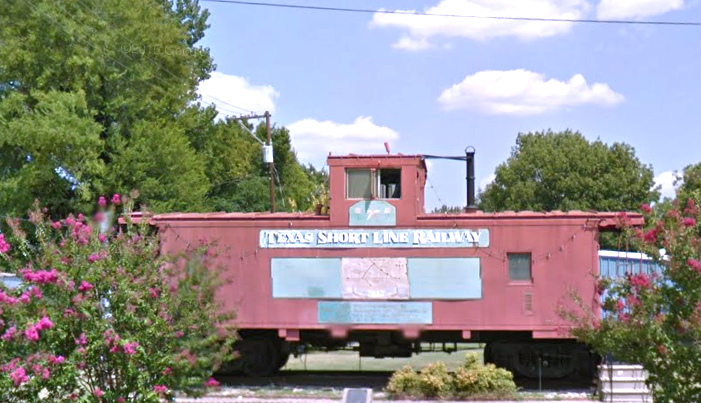
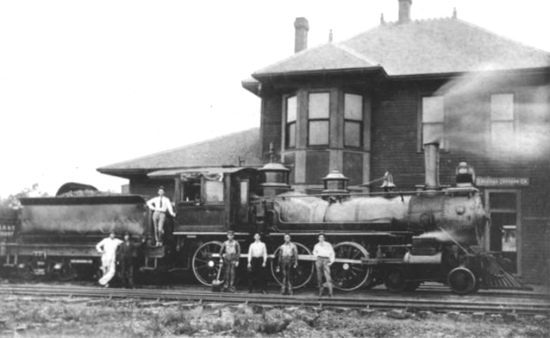
Above Left: This caboose on
static display in Grand Saline is of Union Pacific (UP) heritage, but it is painted
to commemorate the role of the Texas Short Line
(TSL) Railroad in the history of Grand Saline. (Google Street View 2013)
Above Right: The original TSL depot in
Grand Saline featured a two-story bay window. (Grace Museum collection, Abilene)
With a name like Grand Saline, salt must be part of the
story. A salt water marsh in this area of Van Zandt County had long been used by the Caddo and Cherokee
tribes to
create salt by evaporation. By 1845, a commercial salt works had been built by
John Jordon at a site he called Jordan's Saline. Salt was a major trading
commodity because it was the only practical means of preserving meat. Jordan's
land changed hands, and ended up owned by Samuel Richardson prior to the Civil
War. Richardson
donated acreage to the Texas & Pacific (T&P) Railway for a townsite and water
stop as it built west from Marshall toward Dallas in 1872. The T&P's chief
engineer, Grenville M. Dodge, laid out much of the town and named the station
Grand Saline. Jordan's Saline lost its post office and was soon overtaken as
Grand Saline expanded.
Salt production increased at Grand Saline, and it
eventually included direct mining of the rock salt in the enormous salt dome
that sits beneath the area. Transportation provided by the T&P helped to foster
salt commerce which led to investments for improved salt production methods,
further increasing shipments of finished salt. Producing salt required
substantial amounts of energy, so the discovery of lignite deposits near the
community of Alba was a potential boon for the salt industry. Alba was located
on the Missouri, Kansas & Texas (MK&T, "Katy") Railway about nine miles
northeast of Grand Saline. The Katy tracks had been built on a northwest /
southeast alignment between Greenville and
Mineola in 1881, and the line intersected
the T&P at Mineola, thirteen miles east of Grand Saline. Rather than ship coal
from Alba to Mineola and then back west to Grand Saline, J. B. Seeger and others
saw the opportunity for a direct rail line between Alba and Grand Saline. Seeger
owned coal mines at Alba and he envisioned a beneficial flow of commodities in
both directions: coal moving south to Grand Saline to power salt production,
finished salt moving north to Alba for direct shipment to Midwest markets on the
Katy. To effect this
opportunity, the Texas Short Line (TSL) Railway was chartered on February 28,
1901 by Seeger and other investors to build between Alba and Grand Saline.
 Left:
Railway Age, March 21, 1902. The first 4.5
miles of track north from Grand Saline was completed in 1902, and the remaining
4.9 miles was completed in 1903. The TSL did not build into Alba; instead, the
Katy connection was made a half mile southeast of Alba at Hoyt. Nor did the TSL
connect with the T&P in Grand Saline; there was simply no need, thus its tracks
remained north of the T&P.
Left:
Railway Age, March 21, 1902. The first 4.5
miles of track north from Grand Saline was completed in 1902, and the remaining
4.9 miles was completed in 1903. The TSL did not build into Alba; instead, the
Katy connection was made a half mile southeast of Alba at Hoyt. Nor did the TSL
connect with the T&P in Grand Saline; there was simply no need, thus its tracks
remained north of the T&P.
 Right:
Railway & Engineering Review, December
26, 1908. Besides salt, coal and occasional carloads of cotton, the TSL carried
passengers via the Katy connection at Hoyt, but little else. Business was
acceptable for a few years, but in 1908, the TSL went into receivership. The
bankruptcy court announced that the TSL would be put up for sale by auction on January 5, 1909 at
Canton, the county seat of Van Zandt County.
Right:
Railway & Engineering Review, December
26, 1908. Besides salt, coal and occasional carloads of cotton, the TSL carried
passengers via the Katy connection at Hoyt, but little else. Business was
acceptable for a few years, but in 1908, the TSL went into receivership. The
bankruptcy court announced that the TSL would be put up for sale by auction on January 5, 1909 at
Canton, the county seat of Van Zandt County.
Prior to the
auction, a Grand Saline general store merchant, T. B. Meeks, gathered additional
investors and was able to settle all of the liens against the TSL.
It was
released from receivership without being sold. What was behind this sudden
largesse that was able to keep the TSL solvent?
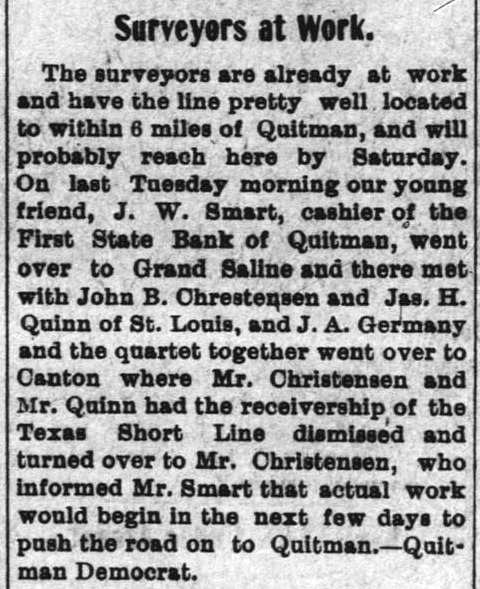 |
Left:
Sulphur Springs Gazette, January 22, 1909, quoting the
Quitman Democrat
Before the end of January, the receivership was
formally dismissed at Canton and one of the participants at the county
courthouse was "J. W. Smart,
cashier of the First State Bank of Quitman". It seems likely that
a major portion of the new money that Meeks had rounded up to save the TSL came from the town of Quitman, county seat
of Wood County. Alba and Mineola were both in Wood County and both had
rail service, but Quitman did not. Quitman was only ten miles due east
of Hoyt, so the idea of extending the TSL to Quitman was plausible, and
a survey was apparently well underway.
Right: Sulphur
Springs Gazette, February 19, 1909
The TSL made no
secret of their intent to build beyond Alba, but they were less
forthcoming with a precise plan. In response to an inquiry from the
Board of Trade at Cooper, Texas, Meeks penned a letter
stating "We have not fully decided as to where we will build. Whether on
to Quitman, in the direction of Cooper and Paris, or whether we go
direct to Sulphur Springs. It greatly depends on the rights of ways and
donations that we receive from points along the line..."
Ultimately, the TSL was never extended beyond Alba. |
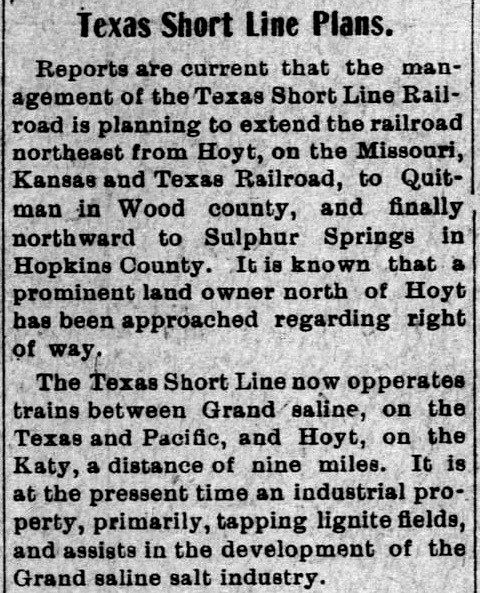 |
Instead of building beyond Alba, the TSL's attention
turned in the other direction. In 1890, direct mining of the rock salt in the
dome beneath Grand Saline had begun, yielding some of the purest salt to be
found anywhere. By 1910, rock salt mining had become a major operation, the
primary source of salt production in Grand Saline. The mine also supported
evaporative production methods wherein water was pumped underground to dissolve
the salt and then pumped back to the surface to be boiled to produce a salt
slurry that was then dried to create finished salt. Unfortunately for the TSL,
the mine was located south of the T&P tracks, hence the TSL did not serve the
mine directly. To rectify this situation, the TSL applied to the Railroad
Commission of Texas (RCT) for permission to build across the T&P tracks in Grand
Saline with a spur track leading into the mine. At least one of the coal mines
near Alba had come under ownership of the salt company, so the ability to ship
coal directly to the mine had gained in importance.
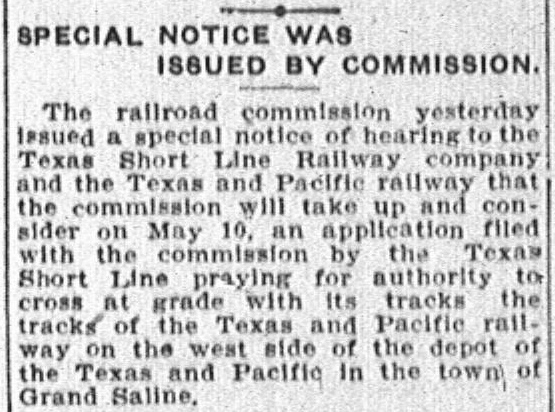
Austin Statesman, April 5, 1910 |
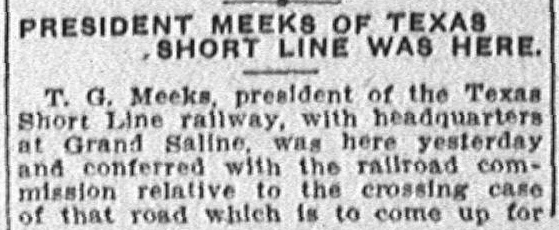
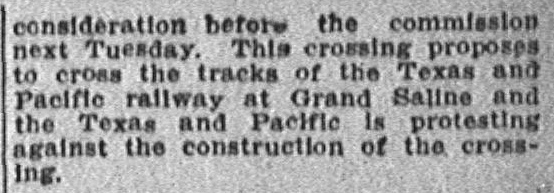
Austin Statesman, May 7, 1910 |
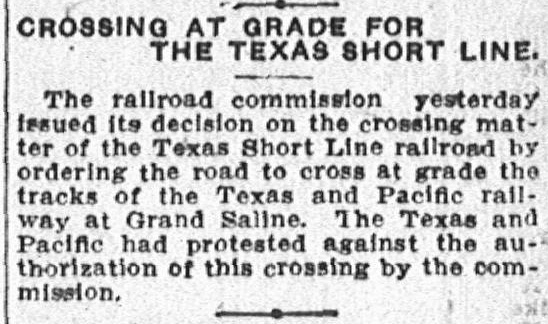
Austin Statesman, May 14, 1910
|
Above: The TSL
appeared before RCT to argue its case for a grade crossing of the T&P at Grand
Saline. The T&P opposed the TSL's application, although the basis of their
opposition is undetermined. The fact that the T&P did not already have a spur to
the mine may have weighed against their case, depending on whether the mine had
sought such service. RCT granted the TSL application and a spur track across the
T&P was built.
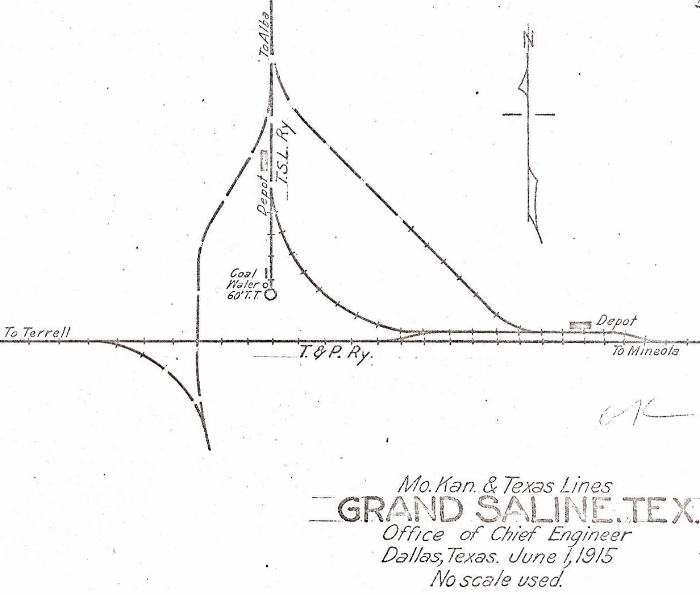 Left:
This 1915 track chart (courtesy Ed Chambers) from the Katy's Office of the Chief
Engineer shows the TSL spur track crossing the T&P main line. The chart does not
show that the track continued south and back to the east to reach the mine which
was (and still is) located about a mile south of the T&P main line.
Left:
This 1915 track chart (courtesy Ed Chambers) from the Katy's Office of the Chief
Engineer shows the TSL spur track crossing the T&P main line. The chart does not
show that the track continued south and back to the east to reach the mine which
was (and still is) located about a mile south of the T&P main line.
The
track chart also shows the T&P connecting to the mine spur, but that connection
does not appear on the 1923 Sanborn Fire Insurance map of Grand Saline (below).
This was most likely a simple oversight on the part of the cartographer as the T&P would have had no incentive to remove an
existing connection to the mine spur.
Note that the "Morton" annotation
on the map reads in full "Morton Salt Cos Salt Field". Around 1920, Morton Salt
Co. acquired the salt mine and all of the salt works in Grand Saline, and it
continues to operate the mine today. Lignite was phased out by Morton in
1941 and replaced by natural gas as the principal energy source for the salt
works.
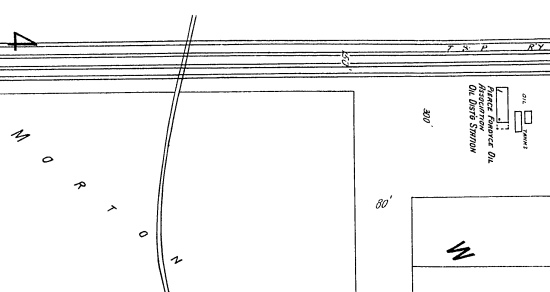
from Sheet 6, Sanborn Fire Insurance map of Grand Saline, April, 1923
RCT construction and abandonment records published by
Charles Zlatkovich in 1980 contain two 1922 entries for abandonments by the TSL.
One is for 1.4 miles between Grand Saline and "Salt Works". The other is for
1.41 miles between Alba and "Coal Mine". The precise circumstances that produced
these records are undetermined. It is not surprising that tracks near the coal
mines would be abandoned; lignite mines depended on relatively inexpensive
surface mining, so mines would close when the easily accessed surface vein had
played out. The abandonment to "Salt Works" is much harder to understand,
especially since the only known spur continues to exist.
RCT had
approved the TSL crossing of the T&P at grade in 1910, but the crossing was
uncontrolled, hence all trains had to stop before passing over the diamond. The
crossing was most likely gated per RCT regulations, and the gate would normally
have been positioned against the TSL. While the presence of a gate did not
eliminate the legal requirement to stop for trains approaching an open gate,
there is evidence that this rule was not enforced for gated crossings located
near a depot, as the Grand Saline crossing was. Trains were generally stopping
at the depot anyway, hence they were already operating at a restricted speed
near the gated crossing.
The T&P had by far the most to gain from the
installation of an interlocker to control the crossing, and on February 20, 1926, RCT commissioned an
eleven-function mechanical interlocker housed in a trackside cabin at the Grand
Saline crossing. The interlocker was formally designated Tower 130 by RCT. The
impetus behind the establishment of this interlocker was
most likely a decision by the T&P to improve train speeds through Grand
Saline. By the mid 1920s, T&P trains could travel longer distances without a
water stop, so a regular stop at Grand Saline had become unnecessary for many
trains. Similarly,
express passenger trains would not normally stop at a small town like Grand
Saline.
 |
Left:
Railway Signaling, October,
1925 |
Cabin interlockers did not become common in Texas until the mid
1920s. They were used in situations where a heavily used line crossed a lightly
used line, the Grand Saline crossing being a classic example. Such crossings
could not justify the operating expense of a manned tower since the signals were
almost always lined to allow continuous movements on the busier line. There
would literally have been nothing for the operators to do except on the
relatively rare occasions that a train on the lightly used line needed to cross.
For the Tower 130 cabin interlocker, the signals would always have been lined to
allow continuous movements on the T&P. They would be reversed only during the period that
a TSL train was actually
crossing the diamond, and thus, it was a crewmember of the TSL train that
operated the controls in the cabin. Once the crossing was complete,
the signals would be returned to the normal position for continuous movements on
the T&P.
From a maintenance perspective, cabin interlockers were
unique in that the railroad that actually operated the controls was from the
lightly used line, whereas the railroad that maintained the interlocker was
typically the one with the busier line. The busier railroad had the stronger
incentive to ensure that the signals, controls and diamond were maintained in
excellent condition. Their higher train volume would cause them to experience a more significant
negative impact if the
crossing became uncontrolled for any period of time due to maintenance issues.
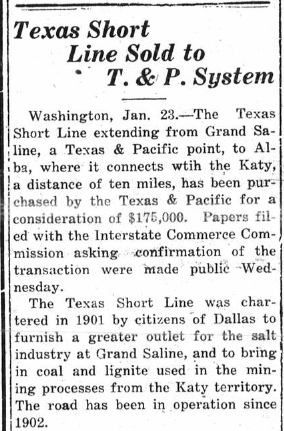 |
Left: Mount Pleasant
Daily Times, January 24, 1929
In early 1929, the T&P purchased the TSL
but continued to operate it as a separate subsidiary. It seems highly
likely that the purchase was a defensive move related to efforts that occurred throughout the 1920s to consolidate
railroads into more efficient "systems." In the Transportation Act of
1920, Congress directed the Interstate Commerce Commission (ICC) to
promote and plan consolidation of U.S. railroads into a limited number
of "systems". The ICC responded by hiring economist William Z. Ripley to
develop a plan. The so-called "Ripley Plan" announced several such
systems, but there was push-back by the railroads which did not
necessarily agree with the allocations made by Ripley. By 1926, Leonor
F. Loree, a long time rail executive and head of the Delaware & Hudson
Railroad, had gained control of the Katy, the St. Louis Southwestern
("Cotton Belt") and the Kansas City Southern (KCS), all of which
operated throughout the southwest, each having a significant presence in
east Texas. Loree proposed a Southwest System that would consolidate the
Katy, KCS and Cotton Belt into one major railroad system operating in
the southwest.
Right:
Grand Saline Sun, January 31,
1929
Meeks appeared before the ICC to testify against the
Loree plan, asking that the TSL either be included within it or granted
better division rates for traffic exchanged at Alba. The American
Short Line Association was lobbying the ICC to require major system
consolidations to account for the interests of the short line railroads.
The T&P's purchase was simply to ensure that no
other major railroad system gained a foothold at Grand Saline by
acquiring the TSL. |
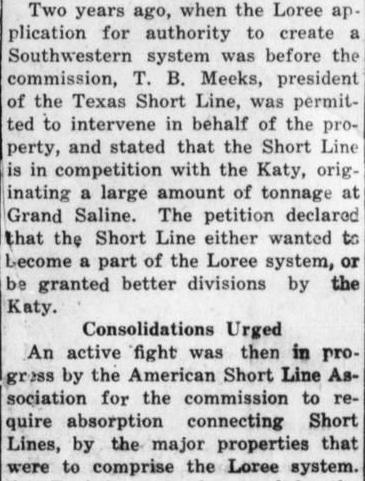 |
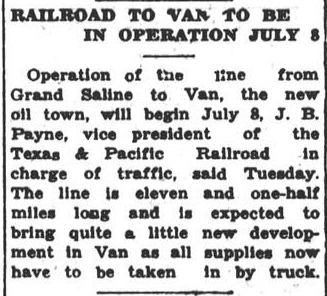 Later in 1929, oil was
discovered near Van, a community located eleven miles southeast of Grand Saline.
The T&P tracks at Grand Saline were reasonably close to Van, but the
International & Great Northern line between Mineola and Lindale was a similar
distance northeast of Van. To get there first, the T&P funded the TSL to build 11.5
miles of tracks south from Grand Saline to Van.
Later in 1929, oil was
discovered near Van, a community located eleven miles southeast of Grand Saline.
The T&P tracks at Grand Saline were reasonably close to Van, but the
International & Great Northern line between Mineola and Lindale was a similar
distance northeast of Van. To get there first, the T&P funded the TSL to build 11.5
miles of tracks south from Grand Saline to Van.
Right:
The Van News (published at Wills Point),
July 4, 1930
By the spring of 1930, the Van oil field was producing
twenty thousand barrels of oil per day. Shipping the oil by rail became an
option when the TSL line was completed in early July. But before the end of the
year, two pipelines had reached Van and oil shipments by rail declined. While
the T&P undoubtedly benefited from the movement of people, supplies and
equipment to and from Van, the prompt introduction of pipelines prevented the huge
bonanza for the T&P that otherwise might have occurred.
The Van oil field
peaked in 1932 with more than seventeen million barrels of oil produced.
Production declined into the 1940s, then ramped back up to over ten million
barrels per year during World War II. The final decline began in the early
1950s, and production in the Van field ended in 1959. The TSL tracks to Van were
abandoned in 1962. Successful secondary production methods revitalized the field
in the 1970s, and the Van field continues to produce oil and natural gas at
modest levels today. The abandonment of the tracks to Van ended the life of the TSL. The
tracks from Grand Saline to Alba had been abandoned in 1959, so there was
literally nothing left.
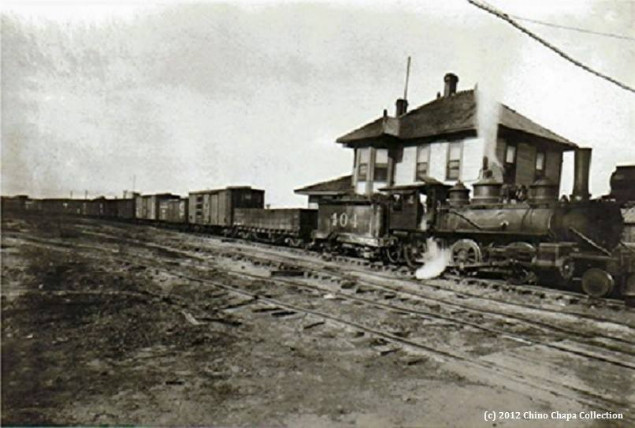
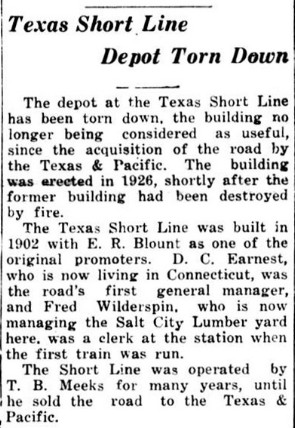 Far
Left: TSL depot, 1902 (Chino Chapa coll.)
Far
Left: TSL depot, 1902 (Chino Chapa coll.)
Near
Left: Grand Saline Sun,
February 27, 1936
Below:
Sanborn Fire Insurance map, Aug. 1909
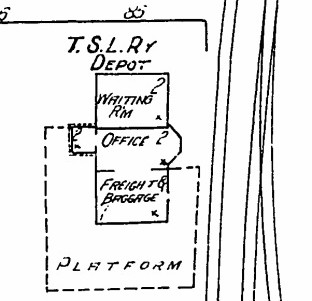
By 1930, Missouri Pacific (MP) owned 75% of the T&P's
stock but did not exercise management control. The two companies worked
cooperatively for many years as MP gradually increased its ownership of the T&P,
reaching more than 96% by the end of 1974. In 1976, the T&P was fully merged
into MP. In 1982, MP was acquired by UP, but it continued to operate under the
MP name until it was fully merged in 1997.
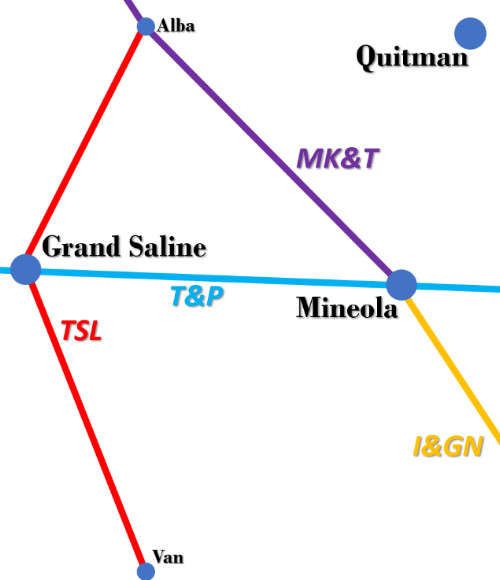
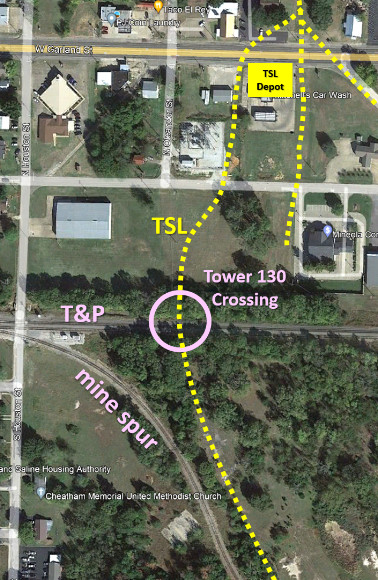
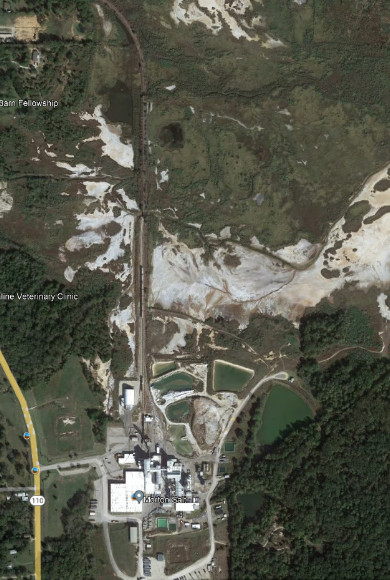
Above Left: This map shows the
railroads near Grand Saline. Among all of these tracks, only the T&P tracks have
fully survived. Above Center:
The TSL depot was located on the west side of the tracks immediately south of
the Garland St. grade crossing. The TSL tracks merged into the existing mine
spur just off the bottom of the map, which is also where the line to Van
continued to the south. Above Right:
The mine spur terminates at the Morton Salt mine located about a mile south of
the UP main line on the east side of Grand Saline. The white landscape is the
vast salt beds that have reached the surface.
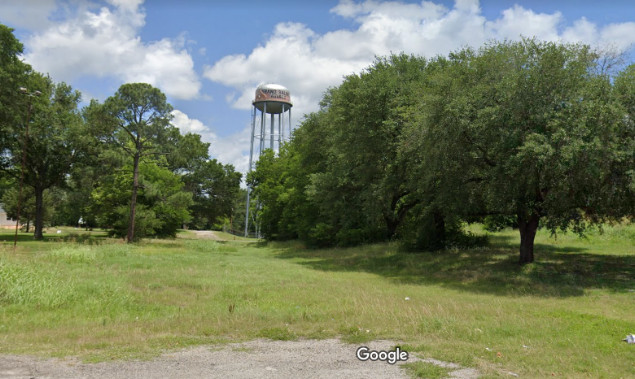
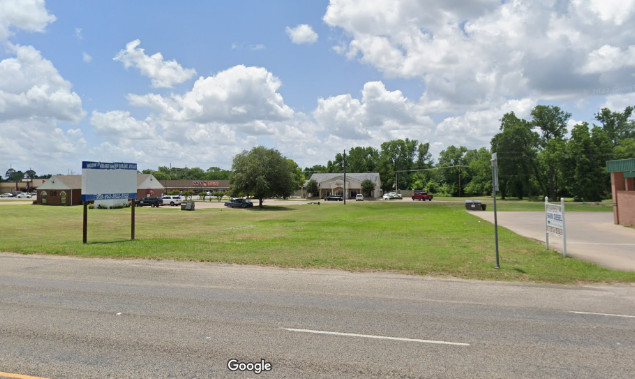
Above: These two 2022 Google Street Views from Garland
St. look north (left) and
south (right) where the TSL
tracks from Alba entered Grand Saline. The water tower sits in the swale of the
TSL line to Alba which narrowed from multiple yard tracks into a single track
going north. South of Garland St., the TSL depot sat where the car wash is
currently located to the right. The
mine spur lead passed along the west side of the depot while yard tracks were
located on the east side. Behind the sign to the left and stretching all
the way back to the buildings in the far distance was a rectangular salt
warehouse that sat at an angle served by both the TSL and the T&P. This had
originally been an evaporation plant of the B. W. Carrington salt works.
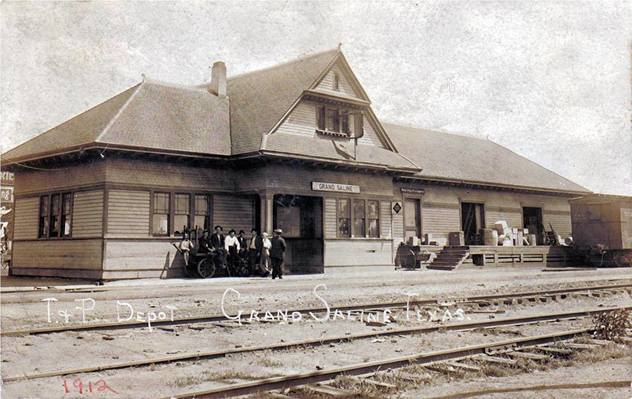
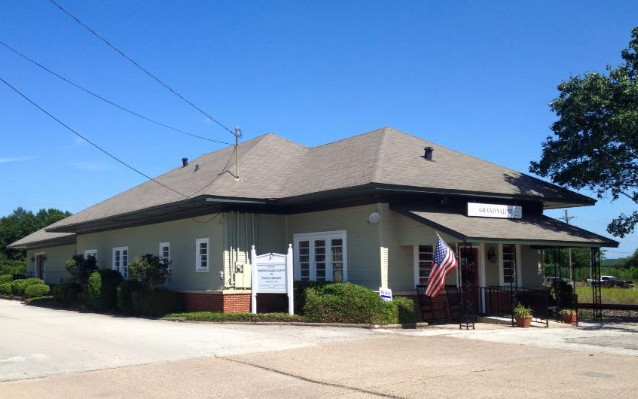
Above Left: T&P depot at Grand
Saline in 1912 (Grand Saline library collection) This was presumably the station
built to replace the initial 1872 depot. Above
Right: This is the "final" T&P depot at Grand Saline.
In the 1980s, the depot was repurposed to house the
Grand Saline Public Library. (Richie
Morgan photo, 2016)















 Later in 1929, oil was
discovered near Van, a community located eleven miles southeast of Grand Saline.
The T&P tracks at Grand Saline were reasonably close to Van, but the
International & Great Northern line between Mineola and Lindale was a similar
distance northeast of Van. To get there first, the T&P funded the TSL to build 11.5
miles of tracks south from Grand Saline to Van.
Later in 1929, oil was
discovered near Van, a community located eleven miles southeast of Grand Saline.
The T&P tracks at Grand Saline were reasonably close to Van, but the
International & Great Northern line between Mineola and Lindale was a similar
distance northeast of Van. To get there first, the T&P funded the TSL to build 11.5
miles of tracks south from Grand Saline to Van. 








